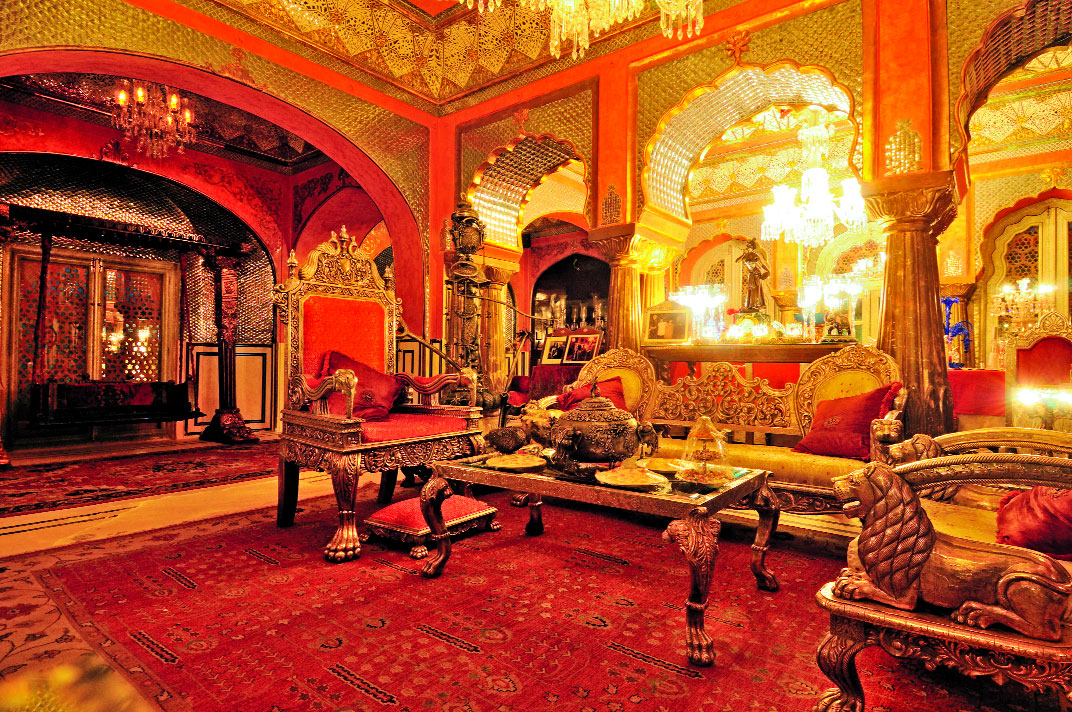Both the ambience and the food are winners at Jaipur’s aristocratic 1135 AD, says Saimi Sattar while Pankaj Kumar gets shutter-happy
Rajput princes would certainly have had it really difficult, confronted as they were with heart-breaking choices from an array of dishes. Whether to dig into the delectable vegetarian bhutte and matar ki sami (corn and peas cutlet) or the crunchy crust and absolutely melt-in-the mouth inners of the gular ke kebab (sycamore flower patties), might have been the cause of much debate. Or they might have voted to bite into the tender and juicy murgh ka soola (chicken starter) and get transported to gastronomic heaven. But then if you decide to dine at 1135 AD at Amer Fort in Jaipur, as I did, you too would be faced with the same choices. Thankfully, if you decide to give your diet a miss for a day, you can eat them all.
However, the decisions about food can be postponed for a little later. As you step into the restaurant, prepare to be dazzled several times over by the ambience. The restaurant, named after the year that the fort was built (1135 AD), is a statement in grandeur. Exquisite chandeliers, silver cladding furniture, photographs that have everyone from lord Mountbatten to Maharani Gayatri Devi, a silver hookah which happens to be the largest in India, a personalised music performance – a relatively endless spectacle is what you encounter. Combined with the service, which is both discreet and at the same time attentive, you have a winner on hand.
Amresh Singh Chauhan, head of operations at the restaurant, says, “We have tried to preserve the heritage. A lot of research and expertise has gone into the creation of a collection of dishes from Mewar, Marwar, Amer, Udaipur and Jodhpur. The dishes use traditional recipes and are cooked using traditional methods.”
There are several different set-ups and divisions in the restaurant so that you can dine in an area which is as private as you want it to be. The open restaurant can seat 150 people, while the private dining area can seat 20. It is here that many of objects d’arts, which can be seen to represent the splendour of Rajputana, are placed. Bollywood buffs might be interested to know that it was in the private dining area that the Fawad Khan-Sonam Kapoor starrer, Khoobsurat, was shot. “The restaurant has played host to the launch of the book Dining with the Nawabs, authored by Meera Ali and photographed by Karam Puri. The Nawabs from all over Asia were present at the launch,” says Chauhan.
But only a great ambience doesn’t a restaurant make. And it can be said of 1135 AD that the food is in keeping with the place to a T. The meat is cooked just right so that it is succulent and juicy, the vegetables retain their flavours and are enhanced by just the right proportion of spices. SS Chauhan, the head chef, says, “The standards are strictly adhered to. The special chillies for lal maans for instance are sourced from Mathania. We make our own paneer. Most of the vegetables are grown organically. Restaurants usually do not go into these details.” The menu at 1135 AD changes every seven days, depending on the season and would feature a speciality of the week.
So what are the must-havesIJ Well almost everything. But some of the starters and the dishes in the thali are worth a mention separately. The chicken tikka, ubiquitous with any and all of the restaurants that serve meat, gets elevated to a different level here. The chicken is cooked just right but not so much that it is dried out. It’s moist, succulent and tender. And the balance is adhered to even with the spices which are not too much or too little.
But vegetarians needn’t feel left out. A bite of Bhutte aur matar ki sami will surely dispel any notion that this is primarily a meat lover’s eatery. The balance is maintained here as well. Both the flavours complement each other without either of them being overpowering. Moreover, the peas have been pulped into a smooth texture while the whole corn kernels give the dish a bite. Another vegetarian starter worth mentioning is the sinfully rich Roomali paneer (cottage cheese sliced as thin as the roomali roti) (Indian bread) and stuffed with khoya (thickened, dried milk) and dry fruits. It is as decadent as it gets. And I cannot miss out on Gular ka kebab, which is covered with poppy seeds and fried. This makes the kebab crunchy outside and melt in the mouth inside — nothing like I have ever had.
Maas ka sula (mutton starter), which Chauhan says is the oldest starter, was made during hunts with basic ingredients to spice it up. But more than the spices, it is the smoky flavour that makes it delicious.
Having eaten an array of starters, I am feeling quite full and the sight of an enormous thali is almost the visual equivalent of a knockout. But if the taste of the starters is anything to go by, the thali was bound to be delicious. I dive into it with gusto — and am not disappointed. Two mutton dishes, the famous lal maans and Amber gosht do not disappoint. Thankfully, the lal maans is not very fiery and suits my palate. Although I am not a huge fan of chicken in its curried avatar, the Murg laung elaichi would certainly be an exception. Delicately flavoured and mildly spiced, the chicken does not have the chewy texture. Amongst the vegetarian fare, Gutta curry gets my vote.
























